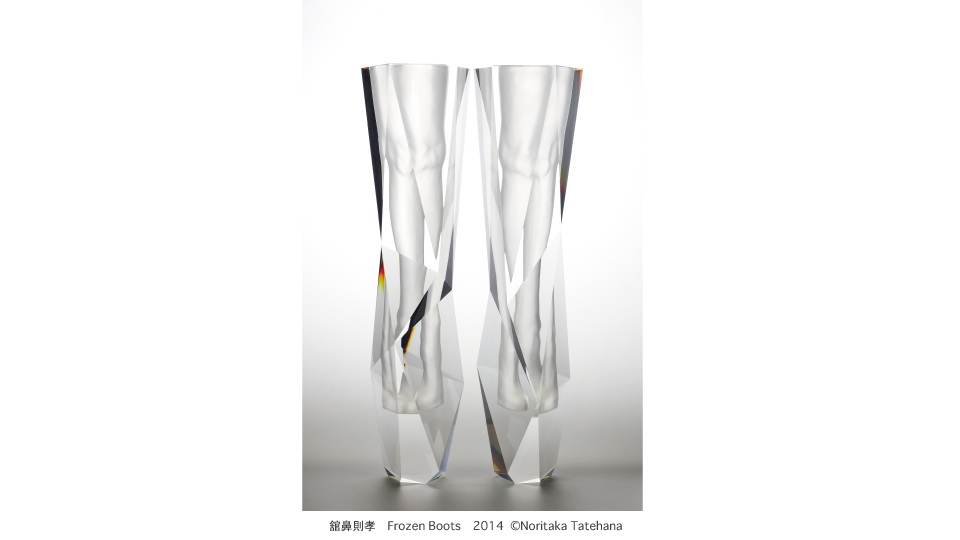
舘鼻則孝 展Noritaka Tatehana
| 会 期 | 2014年12月17日(水) - 2015年1月12日(月) |
|---|---|
| 時 間 | 11:00 - 20:00 ※1月1日は休廊、12月31日は18時までの営業となります。 |
| 場 所 | 8/ ART GALLERY/ Tomio Koyama Gallery |
| 料 金 | 入場無料 Admission Free |
- - - - - - - - - -
舘鼻則孝 アーティストトーク
1/12(月・祝) 14時~15時30分(開場13時30分)
渋谷ヒカリエ8F 8/ COURT(8/ ART GALLERY/ Tomio Koyama Gallery向かい)
ご予約不要/参加無料
展覧会最終日、アーティスト本人が作品について語ります。
皆様ぜひお集まりください。
※当日は開場後、先着順にお席にご案内します。お席には限りがございますので、ご了承ください。
※13時15分より前には、会場前にお並びいただかないよう、お願いいたします。
※イベントに関するお問い合わせは、以下までお願いいたします。
8/ ART GALLERY/ Tomio Koyama Gallery(03-6434-1493 hikarie8@tomiokoyamagallery.com)
- - - - - - - - - -
ー 伝統文化の再構築
舘鼻則孝は、1985年生まれのアーティスト。2006年に東京藝術大学美術学部工芸科に入学し、染織を専攻しました。2010年の大学卒業時に底の厚い靴(ヒールレスシューズ)を制作すると、これがレディー・ガガのスタイリストの目に留まり、専属シューメイカーとなったことで一躍脚光を浴びました。
本展覧会は、舘鼻則孝のアーティストとしての様々な側面をみせる展覧会です。いくつかの美術館に収蔵され、彼のアイコンとも言えるヒールレスシューズのほか、かんざしをモチーフとしたオブジェなど、十数点を展示いたします。
「ヒールレスシューズ」と称される私の大学卒業制作は、海外のファッション業界で注目されたところから始まりました。しかし、それは花魁の履く高下駄から着想を得たものなんです。日本の伝統的な染色技法である友禅染を学んだ大学時代には、古典に倣って着物や下駄の制作をしました。日本的な様式化された平面的な芸術と、西洋的な身体研究に基づく空間的な芸術は、相対する価値観のように感じられますが、それらが共存しているのが現代の日本でもあります。戦後の日本、西洋文化が流入してきた現代だからこそ共有できる価値観が、日本の文化価値を再構築する可能性を秘めているのではないでしょうか。
—舘鼻則孝
彼にとってヒールレスシューズは、ローカルな文化とグローバルな感覚、伝統と革新を確信犯的に行き来する、現代的な感覚を持ち合わせたアート作品なのです。
舘鼻則孝は2010年の東京藝術大学卒業と同時に自身のブランド「NORITAKA TATEHANA」を立ち上げ、ジャパンファッションウィーク、ニューヨークファッションウィークに参加したほか、ブランド創立の翌年には、高校時代にファッションの道を志すきっかけにもなった、コム・デ・ギャルソンにて、東京、パリ、ロンドンの3店舗で展覧会を同時開催しました。
「Future Beauty」(2012年、東京都現代美術館ほか国際巡回)、「イメージメーカー展」(2014年、21_21 DESIGN SIGHT)などのグループ展に参加するなど、近年は積極的にアートの領域に踏み込みながら、作品の発表を行なっています。作品はヴァレリー・スティールが館長を務めるニューヨーク州立ファッション工科大学美術館に、彼女の推薦で収蔵されたほか、メトロポリタン美術館、ヴィクトリア&アルバート博物館、京都服飾文化研究財団などに収められています。
The artist Noritaka Tatehana was born in 1985. He entered Tokyo University of the Arts, Faculty of Fine Arts, Department of Crafts in 2006 and majored in dyeing and weaving design. He created shoes with thick platforms ("Heel-less Shoes") as his 2010 graduation project, and the shoes caught the attention of Lady Gaga's stylist. By becoming her exclusive shoes-maker, he stepped suddenly into the spotlight.
Many sides of Noritaka Tatehana as an artist are presented in this exhibition. Over ten items including Heel-less shoes, his icon that is in the collection of many museums, and one objet created in the motif of a kanzashi (ornamental hair pin) are to be displayed.








